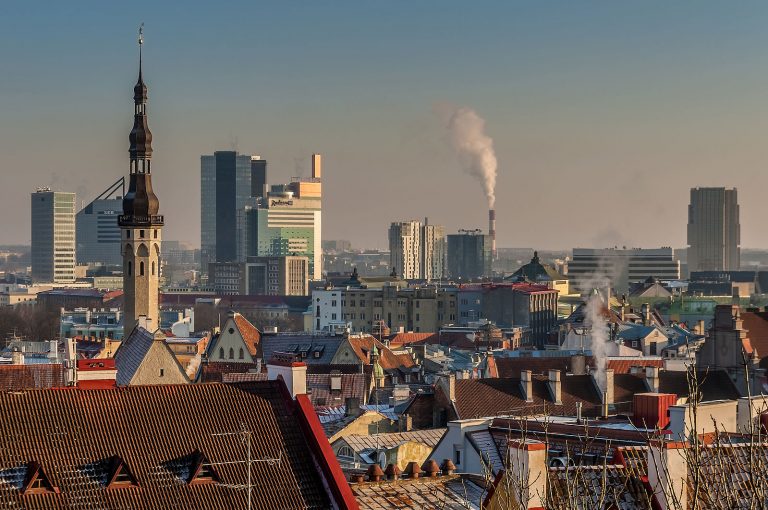Patterns on the window or the scourge of motorists: how two-dimensional ice grows

Everyone knows that water occurs in three states of aggregation. We put the kettle on, and the water begins to boil and evaporate, passing from liquid to gaseous. We put it in the freezer, and it begins to turn into ice, thereby passing from a liquid to a solid state. However, under certain circumstances, water vapor present in the air can immediately go into the solid phase, bypassing the liquid phase. We are familiar with this process by its result – beautiful patterns on the windows on a frosty winter day. Motorists, while scraping an ice layer from a windshield, often characterize this process using not very scientific, but very emotional and vivid epithets. One way or another, the details of the formation of two-dimensional ice for many years were under the cover of mystery. And recently, an international team of scientists for the first time was able to visualize the atomic structure of two-dimensional ice in the process of its formation. What secrets are hidden in this seemingly simple physical process, how did scientists discover them and how useful are their findings? The report of the research group will tell us about this. Go.
Study basis
If you exaggerate, then virtually all of the objects surrounding us are three-dimensional. However, if you consider some of them more meticulously, then you can meet two-dimensional. A crust of ice formed on the surface of something is a prime example. The existence of such structures is not a secret for the scientific community, because they have been analyzed many times already. But the problem is that it is quite difficult to visualize metastable or intermediate structures involved in the formation of 2D ice. This is due to commonplace problems – the fragility and fragility of the studied structures.
Fortunately, modern scanning methods allow you to analyze samples with minimal impact on them, which allows you to get the maximum data in a short period of time, due to the above reasons. In this study, scientists used non-contact atomic force microscopy, while the tip of the microscope needle was coated with carbon monoxide (CO). The combination of these scanning tools makes it possible to obtain real-time images of the edge structures of two-dimensional two-layer hexagonal ice grown on the surface of gold (Au).
Microscopy showed that during the formation of two-dimensional ice, two types of edges (segments connecting two vertices of a polygon) coexist simultaneously in its structure: zigzag (zigzag) and arm-shaped (armchair)
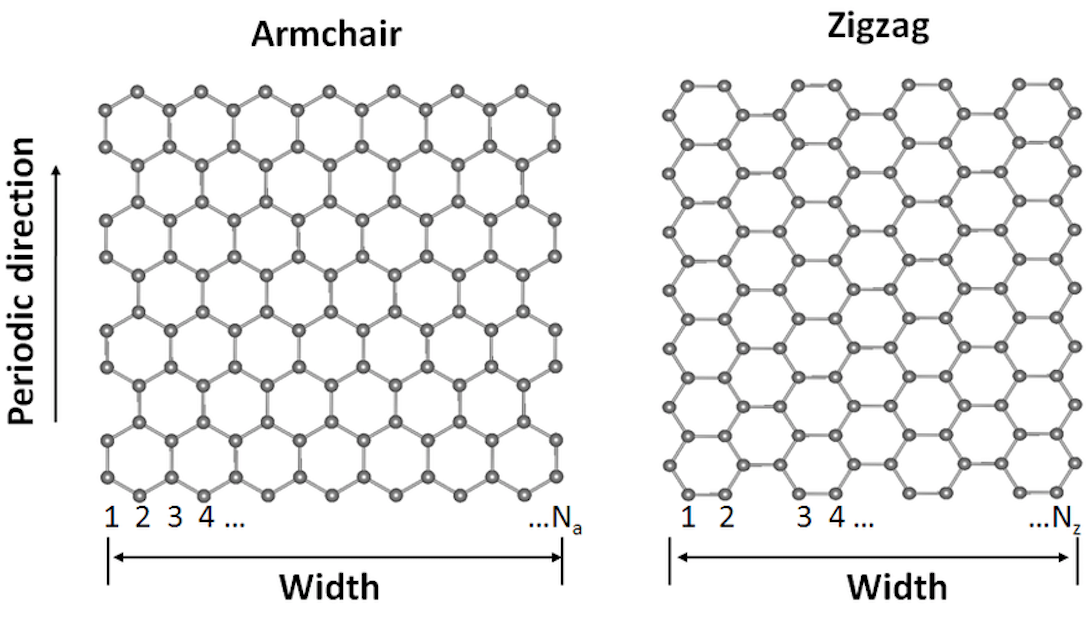
Arm-shaped (left) and zigzag (right) edges using graphene nanotubes as an example.
At this stage, the samples were quickly frozen, which made it possible to examine in detail the structure of atoms. A simulation was also conducted, the results of which largely coincided with the results of observations.
It was revealed that in the case of the formation of zigzag ribs, an additional water molecule is added to the existing rib, and the whole process is regulated by the mechanism of bridge formation. But in the case of the formation of arm-shaped ribs, additional molecules were not found, which contrasts strongly with traditional ideas about the growth of two-layer hexagonal ice and two-dimensional hexagonal substances as a whole.
Why did scientists choose a non-contact atomic force microscope for observation rather than a scanning tunneling microscope (STM) or a transmission electron microscope (TEM)? As we already know, the choice is connected with the complexity of studying short-lived and fragile structures of two-dimensional ice. STM was previously used to study 2D ice grown on various surfaces, however, this type of microscope is not sensitive to the position of the nuclei, and its needle may cause errors in visualization. TEM, on the contrary, perfectly shows the atomic structure of the ribs. However, to obtain high-quality images, high-energy electrons are needed, which can easily change or even destroy the edge structure of covalently bound two-dimensional materials, not to mention weaker bound edges in two-dimensional ice.
An atomic force microscope is devoid of such drawbacks, and a needle coated with CO allows the study of interfacial water with minimal effect on water molecules.
Research results

Image No. 1
Two-dimensional ice was grown on the surface of Au (111) at a temperature of about 120 K, and its thickness was 2.5 Å (1a)
STM ice shots (1c) and the corresponding image of the fast Fourier transform (insert on 1a) show a well-ordered hexagonal structure with a periodicity of Au (111) -√3 x √3-30 °. Although the cellular H-linked network of 2D ice is visible in the STM image, the detailed topology of the edge structures is very difficult to determine. In this case, AFM with a frequency bias (Δf) of the same portion of the sample gave better images (1d), which made it possible to visualize armchair and zigzag sections of the structure. The total length of both options is comparable, but the average length of the predecessor rib is slightly larger (1b) Zigzag ribs can grow up to 60 Å in length, but arm-shaped ribs are covered with defects during the formation, which reduces their maximum length to 10-30 Å.
Next, a systematic AFM visualization was carried out at different needle heights (2a)

Image No. 2
At the highest needle height, when an electrostatic force of a higher order prevails in the AFM signal, two sets of √3 x √3 sublattices in two-dimensional two-layer ice were selected, one of which is shown in 2a (left).
At a lower needle height, the bright elements of this sublattice begin to show directionality, and the other sublattice turns into a V-shaped element (2a, in the center).
With a minimum needle height, the AFM shows a honeycomb structure with clear lines connecting two sublattices resembling H-bonds (2a, on right).
Calculations according to the theory of the density functional show that two-dimensional ice grown on the surface of Au (111) corresponds to a cohesive two-layer ice structure (2s), consisting of two flat hexagonal layers of water. The hexagons of the two sheets are in conjunction, and the angle between the water molecules in the plane is 120 °.
In each layer of water, half of the water molecules lie horizontally (parallel to the substrate), and the other half – vertically (perpendicular to the substrate), with one O – H directed up or down. Vertically lying water in one layer gives the H-bond to horizontal water in another layer, leading to a fully saturated H-shaped structure.
AFM modeling using a quadrupole (dz 2) needle (2b) based on the above model is in good agreement with experimental results (2a) Unfortunately, the similar height of horizontal and vertical water makes it difficult to identify them in the STM imaging process. However, when using atomic force microscopy, the molecules of both types of water are clearly distinguishable (2a and 2b right), because a higher order electrostatic force is very sensitive to the orientation of water molecules.
It was also possible to additionally determine the O-H directivity of horizontal and vertical water through the interaction between higher order electrostatic forces and Pauli repulsion forces, which is shown by red lines on 2a and 2b (in the center).

Image No. 3
In the images 3a and 3b (step 1) enlarged AFM images of zigzag and arm-shaped ribs are shown, respectively. It was found that the zigzag rib grows with the preservation of its original structure, and with the growth of an arm-shaped one, the rib is restored in the periodic structure of 5756 rings, i.e. when the structure of the ribs periodically repeats the sequence pentagon – heptagon – pentagon – hexagon.
Calculations using the theory of the density functional show that the unreconstructed zigzag rib and the armchair-shaped rib of type 5756 are the most stable. The 5756 rib is formed as a result of combined effects that minimize the amount of unsaturated hydrogen bonds and reduce the strain energy.
Scientists recall that the basal planes of hexagonal ice usually end in zigzag ribs, and armchair ribs are absent due to the higher density of unsaturated hydrogen bonds. However, in small systems or in confined spaces, arm-shaped ribs can reduce their energy through proper reconstruction.
As mentioned earlier, when ice growth at a temperature of 120 K was stopped, the sample was immediately cooled to 5 K in order to try to freeze metastable or transition rib structures and provide a relatively long sample life for detailed study using STM and AFM. Two-dimensional ice growth process (image no. 3) was also reconstructed thanks to the CO-functionalized microscope needle, which made it possible to detect metastable and transition structures.
In the case of zigzag ribs, individual pentagons attached to straight edges were sometimes found. They could line up, forming an array with a frequency of 2 x aice (aice – lattice constant of two-dimensional ice). This observation may indicate that the growth of zigzag ribs is initiated by the formation of a periodic array of pentagons (3a, step 1-3), which includes adding two water pairs for the pentagon (red arrows).
Next, the pentagon array joins to form a 56665 type structure (3a, step 4), and then restores the original zigzag appearance, adding more water vapor.
With arm-shaped ribs, the situation is the opposite – there are no pentagon arrays, and instead, short gaps of type 5656 on the edge are often observed. The length of the type 5656 rib is much shorter than that of the 5756. This is probably due to the fact that the type 5656 rib is very tense and less stable than the 5756. Starting from the arm-shaped rib of type 5756, the 575 rings are locally converted to type 656 rings by adding two water vapor (3b, stage 2). Then 656 rings grow in the transverse direction, forming an edge of type 5656 (3b, step 3), but with a limited length due to the accumulation of strain energy.
If one water pair is added to the hexagon of a rib of type 5656, then the deformation can be partially weakened, and this again will lead to the formation of a rib of type 5756 (3b, step 4).
The above results are very indicative, but it was decided to support them with additional data obtained from molecular dynamics calculations of water vapor on the surface of Au (111).
It was found that two-dimensional two-layer ice islands successfully and freely form on the surface, which is consistent with our experimental observations.
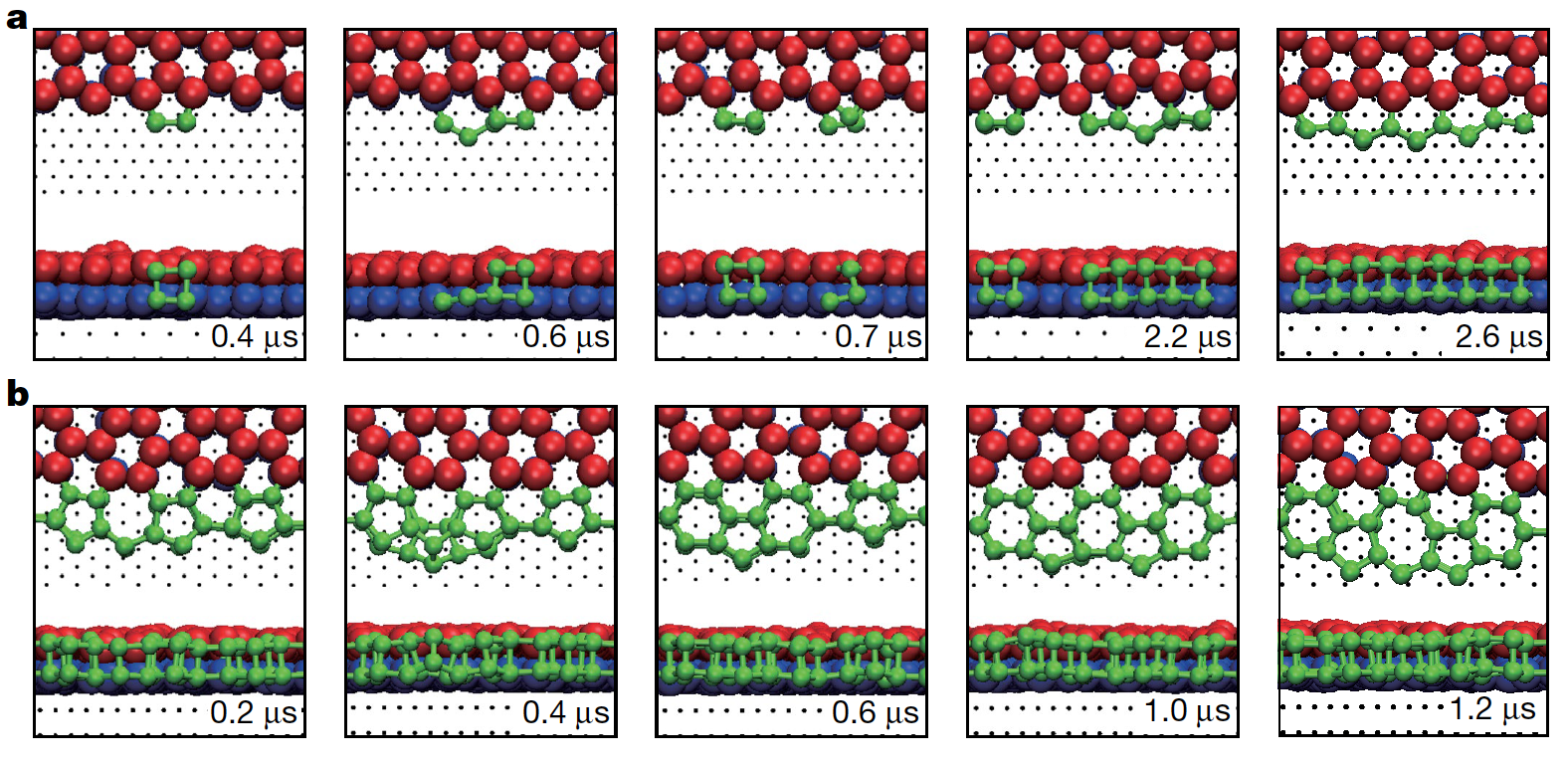
Image No. 4
On the image 4a The mechanism of collective formation of bridges on zigzag ribs is shown in stages.
Below are the media materials for this study with a description.

It is worth noting that one pentagon attached to a zigzag rib cannot act as a local nucleation center that promotes growth.
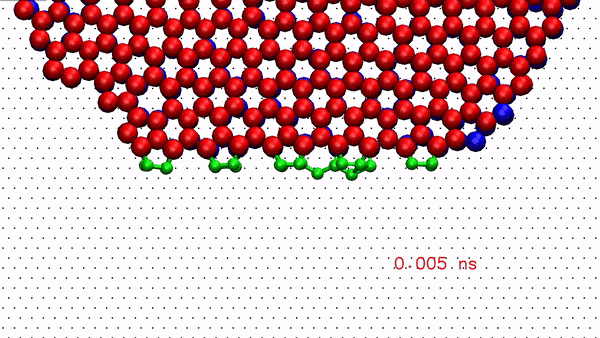
Instead, a periodic but unconnected network of pentagons is initially formed on the zigzag rib, and subsequent incoming water molecules collectively try to connect these pentagons, which leads to the formation of a structure of type 565 chains. Unfortunately, this structure was not observed during practical observations, which is explained by her extremely short life span.
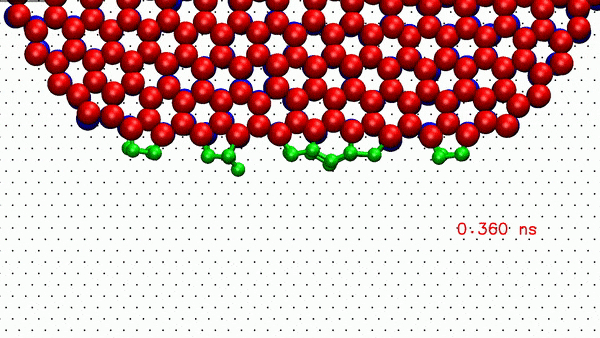
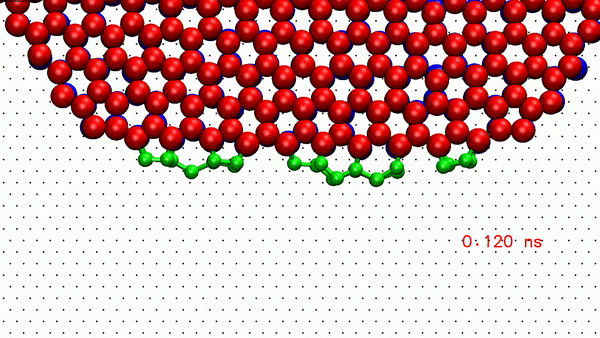
Adding one pair of water connects a structure of type 565 and an adjacent pentagon, which leads to the formation of a structure of type 5666.
A structure of type 5666 grows in the transverse direction, forming a structure of type 56665 and eventually turns into a fully connected hexagonal lattice.
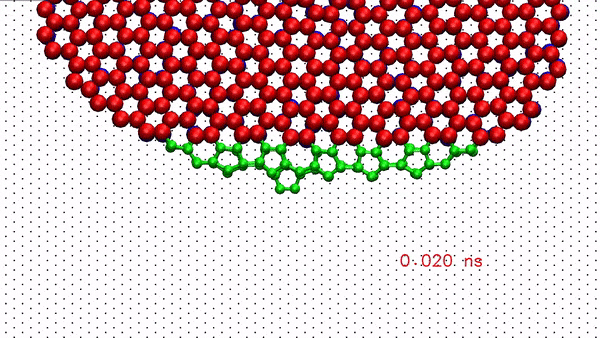

On the image 4b growth is shown in the case of an arm-shaped rib. The conversion from type 575 rings to type 656 rings starts from the bottom layer, forming a composite structure 575/656, which cannot be distinguished from the type 5756 rib in experiments, since only the top layer of two-layer ice can be displayed during the experiments.
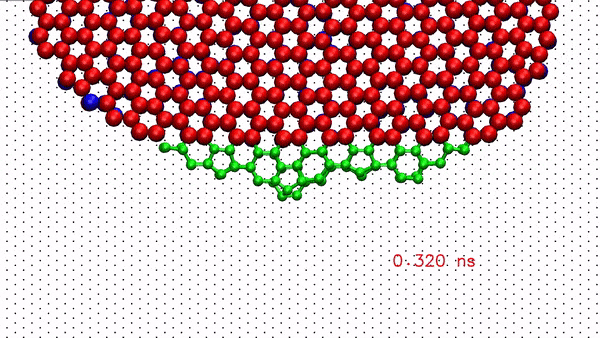
The resulting bridge 656 becomes the nucleation center for the growth of type 5656 rib.

The addition of one water molecule to a rib of type 5656 leads to a very mobile unpaired structure of the molecule.
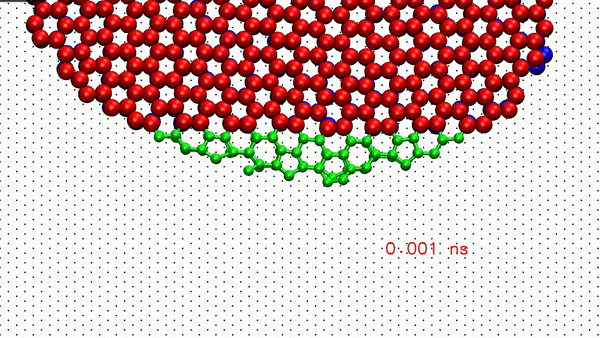
Two of these unpaired water molecules can subsequently combine into a more stable heptagonal structure, completing the conversion from 5656 to 5756.
For a more detailed acquaintance with the nuances of the study, I recommend a look at report of scientists.
Epilogue
The main conclusion of this study is that the observed behavior of structures during growth can be common to all types of two-dimensional ice. Two-layer hexagonal ice is formed on various hydrophobic surfaces and under hydrophobic confinement conditions, and therefore can be considered as a separate 2D crystal (2D ice I), the formation of which is insensitive to the basic structure of the substrate.
Scientists honestly say that their visualization technique is not yet suitable for working with three-dimensional ice, however, the results of studying two-dimensional ice can serve as a basis for explaining the process of formation of its volumetric relative. In other words, an understanding of how two-dimensional structures are formed is an important foundation for the study of three-dimensional ones. For this reason, researchers are planning to improve their methodology in the future.
Thank you for your attention, remain curious and have a good working week, guys. 🙂
A bit of advertising 🙂
Thank you for staying with us. Do you like our articles? Want to see more interesting materials? Support us by placing an order or recommending to your friends, cloud VPS for developers from $ 4.99, A unique analogue of entry-level servers that was invented by us for you: The whole truth about VPS (KVM) E5-2697 v3 (6 Cores) 10GB DDR4 480GB SSD 1Gbps from $ 19 or how to divide the server correctly? (options are available with RAID1 and RAID10, up to 24 cores and up to 40GB DDR4).
Dell R730xd 2 times cheaper at the Equinix Tier IV data center in Amsterdam? Only here 2 x Intel TetraDeca-Core Xeon 2x E5-2697v3 2.6GHz 14C 64GB DDR4 4x960GB SSD 1Gbps 100 TV from $ 199 in the Netherlands! Dell R420 – 2x E5-2430 2.2Ghz 6C 128GB DDR3 2x960GB SSD 1Gbps 100TB – from $ 99! Read about How to Build Infrastructure Bldg. class using Dell R730xd E5-2650 v4 servers costing 9,000 euros for a penny?



![[iOS] Building a Framework using Cocoapods](https://prog.world/wp-content/uploads/2021/11/a3f0ff39bc0ba0b70a883fcac0f0f59b.png)
